By now you should all know the drill. A big GPU manufacturer releases a new high-end GPU, based on a new or updated architecture. Then over the course of the next few months, the company continually fleshes out its product stack until a top-to-bottom line-up of new graphics cards emerges, at a wide range of price points, all based on the same architecture.
If you’ve been paying attention as of late, you’ve probably noticed that AMD recently released a couple of high-end graphics cards— the Radeon HD 7970 and 7950—based on the GPU codenamed “Tahiti”, which sports an entirely new architecture, dubbed Graphics Core Next, or GCN. With the launch of the Radeon HD 7900 series set forth, what we have on tap for you today should come as no surprise. AMD’s current high-end products are based on a new architecture, so it’s time to flesh out the rest of the product stack with some new stuff, of course.
AMD is launching two more Radeon HD 7000 series products today, the Radeon HD 7770 and 7750, but unlike the 7970 and 7950, these two new cards are based on a fresh GPU codenamed “Cape Verde”. Cape Verde has essentially the same feature set as the more powerful Tahiti, but is pared down to target a totally different market segment, and be more affordable and power friendly too.
If you’ve been paying attention as of late, you’ve probably noticed that AMD recently released a couple of high-end graphics cards— the Radeon HD 7970 and 7950—based on the GPU codenamed “Tahiti”, which sports an entirely new architecture, dubbed Graphics Core Next, or GCN. With the launch of the Radeon HD 7900 series set forth, what we have on tap for you today should come as no surprise. AMD’s current high-end products are based on a new architecture, so it’s time to flesh out the rest of the product stack with some new stuff, of course.
AMD is launching two more Radeon HD 7000 series products today, the Radeon HD 7770 and 7750, but unlike the 7970 and 7950, these two new cards are based on a fresh GPU codenamed “Cape Verde”. Cape Verde has essentially the same feature set as the more powerful Tahiti, but is pared down to target a totally different market segment, and be more affordable and power friendly too.
The AMD Radeon HD 7770
|
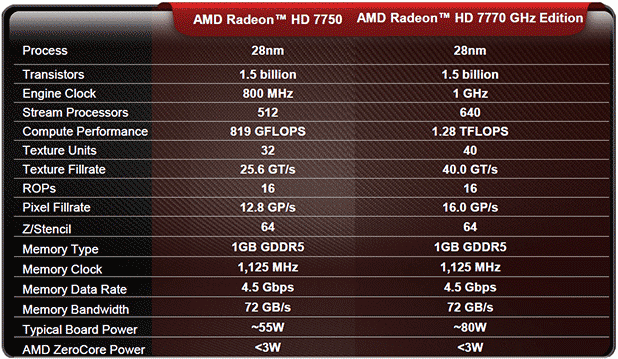
The main features and specifications of the new Radeon HD 7770 and Radeon HD 7750 being released today are outlined in the chart above. We’ll dive into the specifications and take a close look at each card on the next page, but for now the Typical Board Power spec provides a large enough hint to figure out that these cards do not target performance enthusiasts.
With typical board powers of 55 watts (Radeon HD 7750) and 80 watts (Radeon HD 7770), or approximately 4x to 5x lower than the Radeon HD 7900 series cards, it should be clear that these first two members of the Radeon HD 7700 series are targeted at mainstream users or casual gamers looking to upgrade from integrated graphics or an older, previous-generation entry-level graphics card.
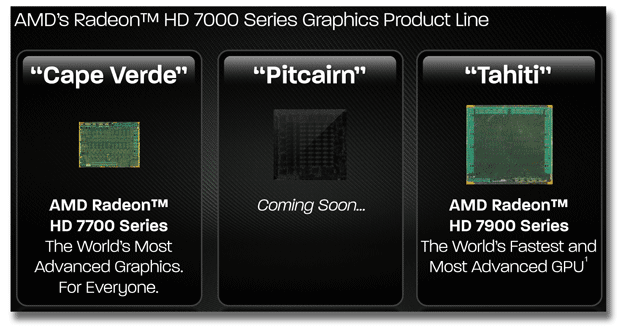
The Cape Verde GPU powering the Radeon HD 7770 and 7750 cards, however, is fairly potent given its position in the Radeon HD 7000 series. It does not target the “sweet” spot of the market though; the GPU codenamed Pitcairn, which will power the Radeon HD 7800 series has that distinction. But if you’ve got the need for an affordable graphics card, with a bleeding edge feature set, and just enough oomph for some casual gaming, read on and check out the Radeon HD 7700s.
As we’ve mentioned, the Cape Verde GPU powering the Radeon HD 7700 series cards is based on the Graphics Core Next (GCN) architecture and has the same feature set as its higher-end counterpart found on the Radeon HD 7900 series.
Like Tahiti, Cape Verde is comprised of roughly 1.5 billion transistors and is manufactured using TSMC’s advanced 28nm process node. The Cape Verde GPU, however, is outfitted with a maximum of 640 stream processors (to Tahiti’s 2,048) arranged in 10 compute units with 64 stream processors each. Cape Verde also sports 512KB of L2 R/W cache, 16 ROPs, 40 texture units, and a 128-bit GDDR5 memory interface. According to AMD, the die size of the chip is a relatively small 123 square millimeters.

Although Cape Verde is pared down to target more mainstream market segments, it doesn’t skimp on any features. With fewer stream processors, ROPs, and texture units, and a narrower memory interface, performance will be lower than Tahiti, but its features remain unchanged as you can see in the feature comparison above.
The card you see here is the Radeon HD 7770 GHz Edition. The Radeon HD 7770 is outfitted with a Cape Verde GPU with all of its functional units intact and enabled. As the full name of this card suggests, the Radeon HD 7770 GHz Edition’s GPU is clocked at a cool 1GHz—a first for a reference GPU from AMD. With a 1GHz Cape Verde GPU paired to 1GB of GDDR5 memory clocked at 1.25GHz (4.5Gbps data rate), the Radeon HD 7770 offers up 1.28 TFLOPS of compute performance, with a texture fillrate of 40GT/s, a pixel fillrate of 16 GP/s, and peak memory bandwidth of 72GB/s.
The card is outfitted with a dual-slot cooler, but a relatively short 8.25” PCB. With only an 80W TDP, the Radeon HD 7770 requires only a single 6-pin PCI Express power feed, and its outputs consist of a single HDMI output, two mini-DisplayPort 1.2 outputs, and one Dual-Link DVI output.
The card is outfitted with a dual-slot cooler, but a relatively short 8.25” PCB. With only an 80W TDP, the Radeon HD 7770 requires only a single 6-pin PCI Express power feed, and its outputs consist of a single HDMI output, two mini-DisplayPort 1.2 outputs, and one Dual-Link DVI output.
The Radeon HD 7750 has the same output configuration as the Radeon HD 7770, but its Cape Verde GPU is pared down somewhat. The GPU at the heart of the Radeon HD 7750 has one of its compute units disabled, so “only” 512 stream processors and 32 texture units are enabled. The GPU is also clocked lower at 800MHz. The Radeon HD 7750’s differences result in 819 GFLOPS (giga vs. tera) of compute performance, with peak texture and pixel fillrates of 25.6 GT/s and 12.8 GP/s, respectively. The card’s memory, however, is clocked at the very same 1.25GHz as the Radeon HD 7770, so memory bandwidth remains unchanged.
With its pared-down, lower clocked, GPU, the Radeon HD 7750 requires less power than the Radeon HD 7770—55w vs. 80w. As such, the Radeon HD 7750 does not require and additional power feeds. The standard 75 Watt power budget provided by a PEG slot is more than enough. The Radeon HD 7750 also has a much shorter 7” PCB and a single-slot cooler design.
With its pared-down, lower clocked, GPU, the Radeon HD 7750 requires less power than the Radeon HD 7770—55w vs. 80w. As such, the Radeon HD 7750 does not require and additional power feeds. The standard 75 Watt power budget provided by a PEG slot is more than enough. The Radeon HD 7750 also has a much shorter 7” PCB and a single-slot cooler design.
How We Configured Our Test Systems: We tested the graphics cards in this article on an Asus P9X79 Deluxe motherboard powered by a Core i7-3960X six-core processor and 16GB of G.SKILL DDR3-1600 RAM. The first thing we did when configuring the test system was enter the system UEFI and set all values to their "optimized" or "high performance" default settings and disabled any integrated peripherals that wouldn't be put to use. The hard drive was then formatted and Windows 7 Ultimate x64 was installed. When the installation was complete we fully updated the OS and installed the latest DirectX redist, along with the necessary drivers, games, and benchmark applications.
|
| Hardware Used: Intel Core i7-3960X (3.3GHz, Six-Core) Asus P9X79 Deluxe (Intel X79 Express) Radeon HD 7770 Radeon HD 7750 Radeon HD 6670 Radeon HD 6790 GeForce GTX 560 Ti GeForce GTX 550 Ti 16GB OCZ DDR3-1600 Western Digital Raptor 150GB Integrated Audio Integrated Network | Relevant Software: Windows 7 Ultimate x64 DirectX April 2011 Redist ATI Catalyst v12.2b NVIDIA GeForce Drivers 290.53 Benchmarks Used: Unigine Heaven v2.5 3DMark 11 Batman: Arkham City Just Cause 2 Alien vs. Predator Metro 2033 Lost Planet 2 Dirt 3 |
|
 Unigine Heaven | Unigine's Heaven Benchmark v2.5 is built around the Unigine game engine. Unigine is a cross-platform, real-time 3D engine, with support for DirectX 9, DirectX 10, DirectX 11 and OpenGL. The Heaven benchmark--when run in DX11 mode--also makes comprehensive use of tessellation technology and advanced SSAO (screen-space ambient occlusion) It also features volumetric cumulonimbus clouds generated by a physically accurate algorithm and a dynamic sky with light scattering. |


The new Radeon HD 7700 series cards offered middling performance in the Unigine Heaven benchmark. The Radeon HD 7770 has no trouble besting the Radeon HD 6790 and GeForce GTX 550 Ti, but trails the GeForce GTX 560. The lower-priced Radeon HD 7750, however, trailed all of the other cards, with the exception of the previous-gen Radeon HD 6670.
|
 Futuremark 3DMark11 | The latest version of Futuremark's synthetic 3D gaming benchmark, 3DMark11, is specifically bound to Windows Vista and WIndows 7-based systems due to its DirectX 11 requirement, which isn't available on previous versions of Windows. 3DMark11 isn't simply a port of 3DMark Vantage to DirectX 11, though. With this latest version of the benchmark, Futuremark has incorporated four new graphics tests, a physics tests, and a new combined test. We tested the graphics cards here with 3DMark11's Performance preset option, which uses a resolution of 1280x720 (720p). |

3DMark11 tells essentially the same story as the Unigine Heaven benchmark from the previous page. The new Radeon HD 7770's performance fell somewhere in between the GeForce GTX 560 and GTX 550, while the lower-end Radeon HD 7750 trailed the pack, with the exception of the Radeon HD 6670.
Before bringing this article to a close, we'd like to cover a few final data points--namely power consumption and noise. Throughout all of our benchmarking and testing, we monitored acoustics and tracked how much power our test system was consuming using a power meter. Our goal was to give you an idea as to how much power each configuration used while idling and while under a heavy workload. Please keep in mind that we were testing total system power consumption at the outlet here, not just the power drawn by the graphics cards alone.

The new Radeon HD 7700 series cards are very power friendly, at idle (sitting at the Windows desktop), the cards consumed least amount of power of the bunch. While under load, the cards also consumed less power than every other card we tested, save for the much slower Radeon HD 6670.
With their relatively low power consumption characteristics, it should come as no surprise that the Radeon HD 7770 and 7750 put out minimal heat and are quiet as well. Somewhat surprisingly, the Radeon HD 7770 seemed to be quieter in our tested, most likely due to its larger heatsink and dual-slot cooler design. The low-profile fan on the Radeon HD 7750, while not loud by any means, produced an audible whir that was somewhat higher pitched than the Radeon HD 7770's.
|

The new Radeon HD 7700 series cards are very power friendly, at idle (sitting at the Windows desktop), the cards consumed least amount of power of the bunch. While under load, the cards also consumed less power than every other card we tested, save for the much slower Radeon HD 6670.
With their relatively low power consumption characteristics, it should come as no surprise that the Radeon HD 7770 and 7750 put out minimal heat and are quiet as well. Somewhat surprisingly, the Radeon HD 7770 seemed to be quieter in our tested, most likely due to its larger heatsink and dual-slot cooler design. The low-profile fan on the Radeon HD 7750, while not loud by any means, produced an audible whir that was somewhat higher pitched than the Radeon HD 7770's.
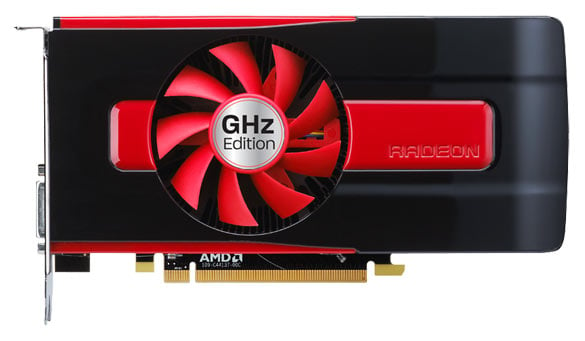
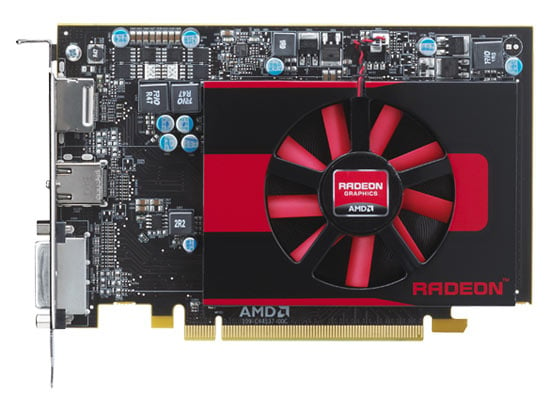
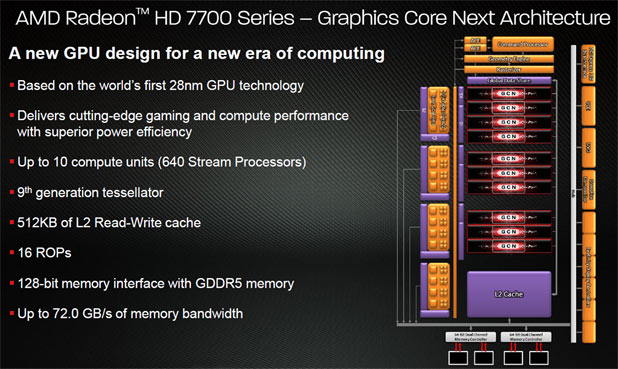
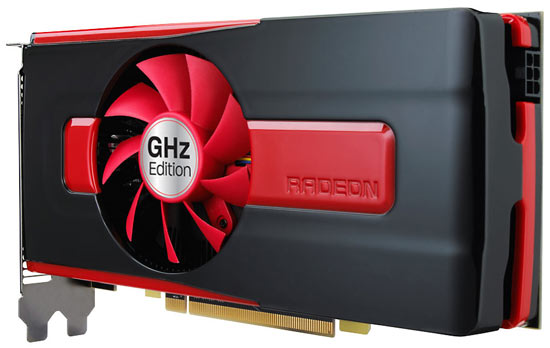
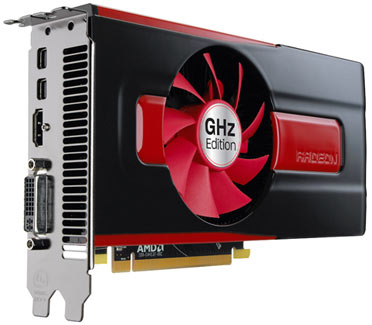
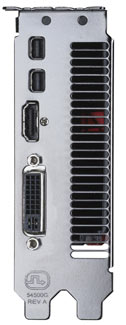
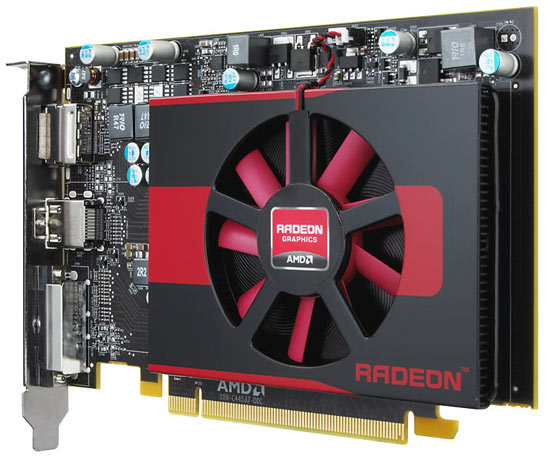
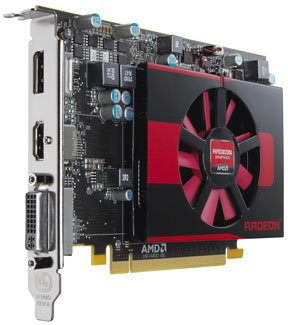


oke bro. .
BalasHapusmakasih udah berkunjung bro. .